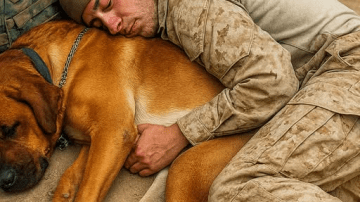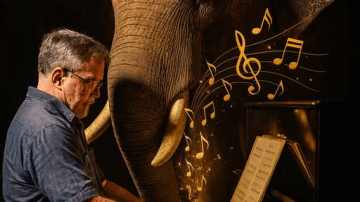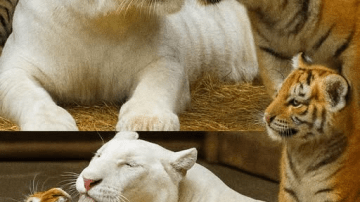The heat in Khartoum was unbearable that day, thick and unmoving, pressing down on the city like a suffocating hand. Inside the crumbling walls of the Al-Qurashi Park Zoo, four lions lay silent under the blazing sun. Their once-golden coats were now pale and patchy, their ribs sharp enough to cut through skin stretched thin from starvation.
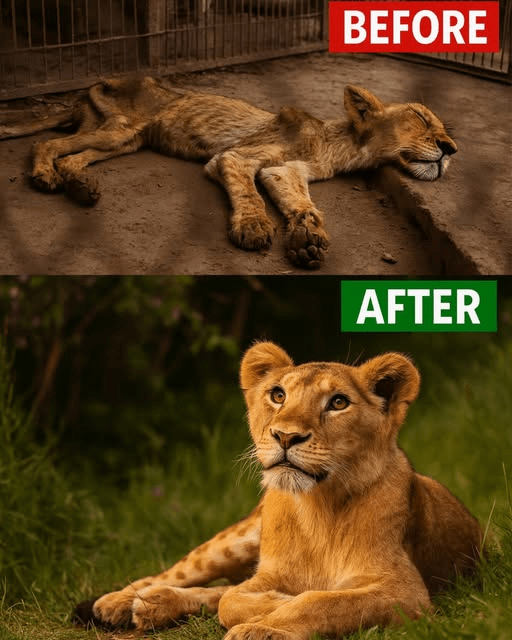
They were the ghosts of what they had once been—creatures of majesty and power reduced to fragile shadows. Their eyes, once bright with pride, were now hollow and distant. Each shallow breath was a struggle, each movement a battle.
For months, they had been forgotten.
The Zoo That Time Abandoned
The Al-Qurashi Park Zoo had once been a modest attraction in Sudan’s capital—a place where families came to see lions, monkeys, and gazelles. But as the country’s political and economic crises deepened, the zoo’s gates began to close more often than they opened.
Funds dried up. Keepers went unpaid. Food shipments stopped arriving.
By the time the story began to unfold, most of the animals were already gone—either dead from starvation or taken away by whoever could rescue them. What remained were cages full of silence, the smell of decay, and the faint cries of four starving lions clinging to life.
A Cry That Shook the World
It was a local caretaker who first posted the photos online—images so haunting they looked unreal. The lions were skeletal, their bodies collapsed in on themselves, their eyes pleading in quiet despair.
The pictures spread faster than anyone expected. Within hours, hashtags like #SudanLions and #SaveKhartoumLions were trending worldwide. People couldn’t believe what they were seeing.
“How could this happen?” one commenter wrote.
“Where is humanity?” asked another.
The outrage quickly turned into action. Messages flooded in from across the globe. Wildlife activists, doctors, and ordinary people demanded something be done.
Among those who answered the call was a team from Four Paws International, a global animal welfare organization known for emergency rescues in war zones and disaster areas.
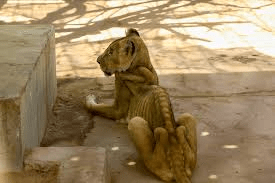
The Race Against Time
Led by veterinarian Dr. Amir Khalil, the team landed in Khartoum just days after the story went viral. They were greeted not by order or preparation, but by chaos.
Paperwork was missing. Customs officials had seized their medical supplies. The zoo’s infrastructure was collapsing.
And the lions—those magnificent animals—were barely alive.
Dr. Khalil and his team moved fast, despite the obstacles. They examined each lion, their hands trembling with a mix of urgency and heartbreak. “Their muscles are gone,” he whispered. “You can’t even find a place to inject medicine.”
The lions’ bodies had consumed nearly all their fat and tissue in a desperate attempt to survive. Even giving them food was risky; too much too soon could kill them. Every step had to be measured, every decision life or death.
The First Loss
There were four lions when the world first saw the pictures. But by the time Four Paws arrived, one lioness was already too weak.
Despite their best efforts, she slipped away in the night. Her passing was quiet, unnoticed by the world she had once symbolized. The rescuers covered her with a blanket and stood in silence.
It was a harsh reminder of how fragile hope can be when it arrives too late.
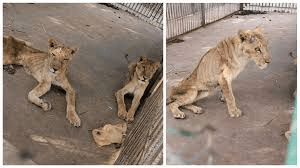
The Fight for the Living
The remaining lions were placed on a strict recovery plan. Tiny portions of meat were given every few hours—just enough to rebuild strength without shocking their systems. Water was filtered and infused with electrolytes. Vitamins and medications were administered whenever their fragile veins could bear it.
For days, no one knew if they would make it. They were too weak to stand, their eyes glazed over in exhaustion. The rescuers took shifts through the night, speaking softly, offering comfort, willing them to fight.
Then, something changed.
One morning, as the sun broke over Khartoum, one of the males—his mane sparse but golden—lifted his head. Slowly, unsteadily, he sat up. His keepers froze, tears welling in their eyes.
It was the smallest of victories, but it meant everything.
The World Responds
As news of the rescue spread, donations began pouring in. Thousands of people from dozens of countries sent money, supplies, and messages of encouragement.
Children wrote letters. Artists painted portraits of the lions. A small wave of global compassion began to build.
“This isn’t about politics or religion,” Dr. Khalil told a local reporter. “This is about humanity.”
His words struck a chord. In a region scarred by war, drought, and hunger, the sight of people uniting for something so pure—so simple as saving life—was deeply moving.
The Road to Recovery
With continued care, the surviving lions began to change. Their ribs, once sharp ridges, slowly faded beneath healthy muscle. Their eyes grew clearer, their movements steadier.
The team named them Kandaka, Mani, and Sayeeda—names that carried meaning in Sudanese culture: strength, dignity, and hope.
They were transferred to a safer enclosure, and for the first time in years, they roamed freely within their new space. They basked in the sun. They ate heartily. They lived.
The sound of their roars—once faint and strained—returned, echoing across the sanctuary. It was as if they were reclaiming their place in the world, their voices finally heard.
Beyond the Cage
The story of the Khartoum lions became more than an act of rescue—it became a mirror.
It forced people to confront uncomfortable truths about neglect, responsibility, and the shared duty of compassion. These animals were not victims of nature—they were victims of humanity’s indifference.
And yet, it was that same humanity that saved them.
Dr. Khalil and his team continued to work across conflict zones—from Syria to Gaza to Sudan—bringing care to animals left behind by war and poverty. But he often said the lions of Khartoum left a mark unlike any other.
“They reminded the world,” he said softly, “that compassion has no borders.”
The Symbol of Hope
Today, the surviving lions of Khartoum are thriving under protection. They have become symbols of resilience—not just for animals, but for people living in hardship everywhere.
Their story still circulates online, not as a tale of tragedy, but as one of redemption.
In a place where despair had become the norm, a handful of starving lions awakened something powerful—the collective heartbeat of compassion that still exists, even in the darkest corners of the world.
The cages of Al-Qurashi Park Zoo may have fallen silent, but their story roars on—a reminder that kindness, when shared, can breathe life back into the forgotten.
And sometimes, even the weakest roar can shake the world.

